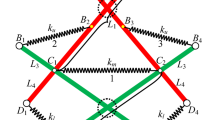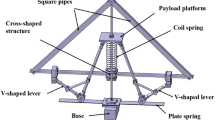Abstract
Purpose
This paper proposes a novel dual four-rod horizontal large-amplitude quasi-zero stiffness (QZS) vibration isolator based on the singular configuration of a planar four-rod mechanism combined with gravity compensation.
Methods
First, the mechanism design and three-dimensional model of dual four-rod horizontal vibration isolator are established. Second, kinematic characteristics are analyzed, and trajectory planning is carried out to obtain the kinematic performance. Then, based on the artificial fish swarm algorithm, the appropriate size and mass of the component are solved, and the QZS characteristics of the isolator are optimized. Third, the statics and dynamics theoretical models of isolators are established, and the transmissibility of isolators under different dam** ratios and excitation amplitudes is solved by simulation experiments. Finally, the experimental prototype is established, and the experiment of resilience and acceleration transmissibility is carried out to verify the effectiveness of low-frequency vibration isolation.
Results
The static and dynamic simulation analysis of isolator well verifies the theoretical solution of isolator. According to the theoretical model, different vibration isolation performance can be obtained with different input parameters. The experimental results of the prototype show that the isolator has lower initial vibration isolation frequency and wider vibration isolation bandwidth.
Conclusion
The dual four-rod horizontal large-amplitude QZS isolator designed in this paper shows good performance in isolating the external excitation of the low-frequency large vibration amplitude. Since the medical precision instrument will inevitably produce low-frequency vibration during the transportation process and reduce the accuracy and stability of the equipment, in order to reduce the possibility of the instrument being damaged during the transportation process, the vibration isolator has great application potential in the isolation of medical precision instrument.













Similar content being viewed by others
Availability of Data and Materials
The data used to support the findings of this study are included within the article.
Code Availability
Not applicable.
References
Zou W, Cheng C, Ma R et al (2021) Performance analysis of a quasi-zero stiffness vibration isolation system with scissor-like structures[J]. Arch Appl Mech 91:117–133
Yan B, Yu N, Ma H et al (2022) Crosspolar variations on a satellite-Earth path[J]. Mech Syst Signal Process 167:108507
Li M, Cheng W, **e R (2020) Design and experiments of a quasi–zero-stiffness isolator with a noncircular cam-based negative-stiffness mechanism[J]. J Vib Control 26(21–22):1935–1947
Martínez-Pañeda E, Fleck NA (2018) Crack growth resistance in metallic alloys: the role of isotropic versus kinematic hardening[J]. J Appl Mech 85(11):111002
Sadeghi S, Li S (2019) Fluidic origami cellular structure with asymmetric quasi-zero stiffness for low-frequency vibration isolation[J]. Smart Mater Struct 28(6):065006
Ledezma-Ramírez DF, Tapia-González PE, Ferguson N et al (2019) Recent advances in shock vibration isolation: An overview and future possibilities[J]. Appl Mech Rev 71(6):060802
Ding H, Ji J, Chen LQ (2019) Nonlinear vibration isolation for fluid-conveying pipes using quasi-zero stiffness characteristics[J]. Mech Syst Signal Process 121:675–688
Ye K, Ji JC (2022) An origami inspired quasi-zero stiffness vibration isolator using a novel truss-spring based stack Miura-ori structure[J]. Mech Syst Signal Process 165:108383
Abuabiah M, Dabbas Y, Herzallah L et al (2022) Analytical study on the low-frequency vibrations isolation system for vehicle’s seats using quasi-zero-stiffness isolator[J]. Appl Sci 12(5):2418
Yan G, Zou HX, Wang S et al (2022) Bio-inspired toe-like structure for low-frequency vibration isolation[J]. Mech Syst Signal Process 162:108010
Zhang Q, Guo D, Hu G (2021) Tailored mechanical metamaterials with programmable quasi-zero-stiffness features for full-band vibration isolation[J]. Adv Func Mater 31(33):2101428
Carrella A, Brennan MJ, Kovacic I et al (2009) On the force transmissibility of a vibration isolator with quasi-zero-stiffness[J]. J Sound Vib 322(4–5):707–717
Xu D, Zhang Y, Zhou J et al (2014) On the analytical and experimental assessment of the performance of a quasi-zero-stiffness isolator[J]. J Vib Control 20(15):2314–2325
Lan CC, Yang SA, Wu YS (2014) Design and experiment of a compact quasi-zero-stiffness isolator capable of a wide range of loads[J]. J Sound Vib 333(20):4843–4858
Bouna HS, Nbendjo BRN, Woafo P (2020) Isolation performance of a quasi-zero stiffness isolator in vibration isolation of a multi-span continuous beam bridge under pier base vibrating excitation[J]. Nonlinear Dyn 100:1125–1141
Zhao F, Cao S, Luo Q et al (2022) Practical design of the QZS isolator with one pair of oblique rods by considering pre-compression and low-dynamic stiffness[J]. Nonlinear Dyn 108(4):3313–3330
Alabuzhev P, Gritchin KL et al (1989) Vibration protecting and measuring systems with quasi-zero-stiffness[M]. Hemisphere Publishing Corporation, London, pp 7–21
Carrella A, Brennan MJ, Waters TP (2007) Static analysis of a passive vibration isolator with quasi-zero-stiffness characteristic[J]. J Sound Vib 301(3–5):678–689
Carrella A, Brennan MJ, Waters TP et al (2012) Force and displacement transmissibility of a nonlinear isolator with high-static-low-dynamic-stiffness[J]. Int J Mech Sci 55(1):22–29
Kovacic I, Brennan MJ, Waters TP (2008) A study of a nonlinear vibration isolator with a quasi-zero stiffness characteristic[J]. J Sound Vib 315(3):700–711
Zhou J, Wang X, Xu D et al (2015) Nonlinear dynamic characteristics of a quasi-zero stiffness vibration isolator with cam–roller–spring mechanisms[J]. J Sound Vib 346:53–69
Kim J, Jeon Y, Um S et al (2019) A novel passive quasi-zero stiffness isolator for ultra-precision measurement systems[J]. Int J Precis Eng Manuf 20:1573–1580
Dalela S, Balaji PS, Jena DP (2022) Design of a metastructure for vibration isolation with quasi-zero-stiffness characteristics using bistable curved beam[J]. Nonlinear Dyn 108(3):1931–1971
Zhang C, Li X, Zhang S et al (2022) Design and analysis of quasi-zero stiffness torsional vibration isolator adapting to load changes[J]. J Vib Shock 41(23):307–314
Zhou X, Sun X, Zhao D et al (2021) The design and analysis of a novel passive quasi-zero stiffness vibration isolator[J]. J Vib Eng Technol 9(2):225–245
Liu X, Zhao Q, Zhang Z et al (2019) An experiment investigation on the effect of coulomb friction on the displacement transmissibility of a quasi-zero stiffness isolator[J]. J Mech Sci Technol 33:121–127
Burian YA, Silkov MV, Sitnikov DV (2020) Quasi-zero stiffness vibration isolation support with stiffness corrector based on a rubber-cord air spring[C]. AIP Conf Proc AIP Publ LLC 2285(1):030007
Cai C, Zhou J, Wu L et al (2020) Design and numerical validation of quasi-zero stiffness metamaterials for very low-frequency band gaps[J]. Compos Struct 236:111862
Zhou J, Pan H, Cai C et al (2021) Tunable ultralow frequency wave attenuations in one-dimensional quasi-zero stiffness metamaterial[J]. Int J Mech Mater Des 17:285–300
**ng ZY, Yang XD (2023) A combined vibration isolation system with quasi-zero stiffness and dynamic vibration absorber[J]. Int J Mech Sci 256:108508
Zeng R, Wen G, Zhou J et al (2021) Limb-inspired bionic quasi-zero stiffness vibration isolator[J]. Acta Mech Sin 37(7):1152–1167
Chai Y, **g X, Guo Y (2022) A compact X-shaped mechanism based 3-DOF anti-vibration unit with enhanced tunable QZS property[J]. Mech Syst Signal Process 168:108651
Ling P, Miao L, Ye B et al (2023) Ultra-low frequency vibration isolation of a novel click-beetle-inspired structure with large quasi-zero stiffness region[J]. J Sound Vib 558:117756
Funding
This research was funded by the National Natural Science Foundation, China (Grant no. 52105009), by the Project of Shenzhen Municipal Science and Technology Innovation Council (Grant no. KCXFZ20201221173202007), by the Key Scientific Research Platforms and Projects of Guangdong Regular Institutions of Higher Education, China (Grant no. 2022KCXTD033), by the Scientific Research Capacity Improvement Project of Key Develo** Disciplines in Guangdong Province, China (Grant no. 2021ZDJS084), by the Guangdong Natural Science Foundation, China (Grant no. 2023A1515012103), by the Key Laboratory of Robotics and Intelligent Equipment of Guangdong Regular Institutions of Higher Education, China (Grant no. 2017KSYS009), and by the Innovation Center of Robotics and Intelligent Equipment, China (Grant no. KCYCXPT2017006).
Author information
Authors and Affiliations
Contributions
Conceptualization, SW, LY, QZ and RX; methodology, SW, LY and QZ; software, SW and LY; validation, SW and LY; investigation, SW, QZ; data curation, SW, LY and QZ; writing—original draft preparation, SW and LY; writing—review and editing, SW, LY and QZ; visualization, SW; supervision, QZ, RX; project administration, QZ, RX; funding acquisition, QZ. All the authors have read and agreed to the published version of the manuscript.
Corresponding author
Ethics declarations
Conflict of Interest
The authors declare that there is no conflict of interest.
Ethics Approval
Not applicable.
Consent to Participate
Not applicable.
Consent for Publication
Not applicable.
Additional information
Publisher's Note
Springer Nature remains neutral with regard to jurisdictional claims in published maps and institutional affiliations.
Rights and permissions
Springer Nature or its licensor (e.g. a society or other partner) holds exclusive rights to this article under a publishing agreement with the author(s) or other rightsholder(s); author self-archiving of the accepted manuscript version of this article is solely governed by the terms of such publishing agreement and applicable law.
About this article
Cite this article
Wang, S., Yu, L., Zhang, Q. et al. Design and Analysis of a Novel Horizontal Large-Amplitude and Low-Frequency Vibration Isolator. J. Vib. Eng. Technol. 12, 6155–6167 (2024). https://doi.org/10.1007/s42417-023-01244-5
Received:
Revised:
Accepted:
Published:
Issue Date:
DOI: https://doi.org/10.1007/s42417-023-01244-5




